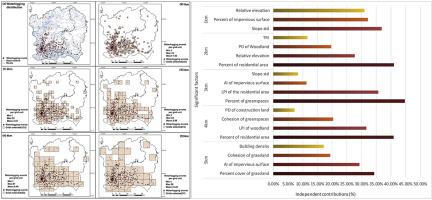Journal of Environmental Management ( IF 8.7 ) Pub Date : 2020-06-22 , DOI: 10.1016/j.jenvman.2020.110951 Qifei Zhang 1 , Zhifeng Wu 2 , Hui Zhang 3 , Giancarlo Dalla Fontana 4 , Paolo Tarolli 4

|
Urban waterlogging disasters are affected by environmental conditions and human activities. Previous studies had explored the effect of land-use type on waterlogging in relatively small watersheds. Few, however, have comprehensively revealed the relative contributions of the environmental and anthropogenic factors to urban waterlogging concerning different scales of analysis. Indeed what is less known, are the dominant factors and the appropriate scale of analysis. To overcome this limitation, a novel method that integrates the stepwise regression model with hierarchical partitioning analysis is presented. The purpose is to investigate the complex mechanism of urban waterlogging by identifying the relative contribution of each environmental and anthropogenic factor and the stability linking waterlogging to influencing factors at multiple scales of analysis (i.e. 1 km, 2 km, 3 km, 4 km, and 5 km). We consider waterlogging events in the central urban districts of Guangzhou (PR China) from 2009 to 2015 as a case study. The results show that the spatial distribution of waterlogging events in the central urban area presents a strong agglomeration pattern. The waterlogging hot spots are mainly concentrated in the historical area of Guangzhou. Under all analysis scales, we find that the percent cover of urban green spaces (44.74%), percent cover of residential area (41.03%), and slope.std (36.85%) both have a dominant contribution to urban waterlogging, which suggests the importance of land cover composition in determining urban waterlogging. However, the relative contribution and dominant factors of waterlogging varied across different analysis scales, presenting a strong scale effect. Under a small analysis scale (1 km), the topography factors (slope.std and relative elevation) are confirmed as the dominant variables; however, with the increase of analysis scale, the influence of land cover composition (greenspace, residence area, grassland) and land cover spatial configuration (LPI, AI, Cohesion index) on waterlogging magnitude is greater than other factors. This finding provides additional insights that the urban waterlogging can be alleviated by balancing the relative composition of land cover features as well as by optimizing their spatial configuration. Since the optimal statistical scale for urban waterlogging studies only worked for specific influencing factors, the appropriate analysis scale for urban waterlogging study should be determined by the characteristics of study areas. This study has the capability to extend our scientific understanding of the complex mechanisms of waterlogging in the highly urbanized coastal city, providing useful support for the prevention and management of urban waterlogging.


























 京公网安备 11010802027423号
京公网安备 11010802027423号